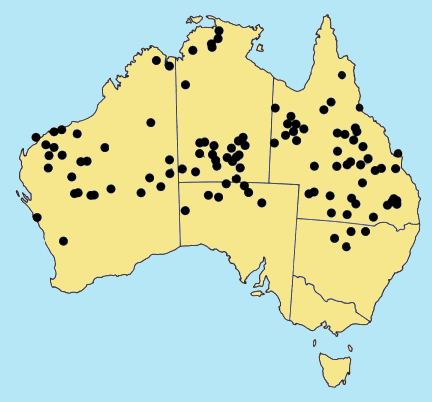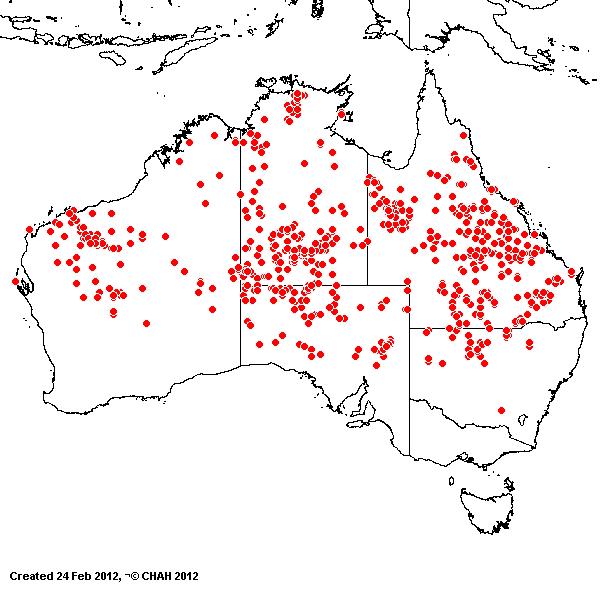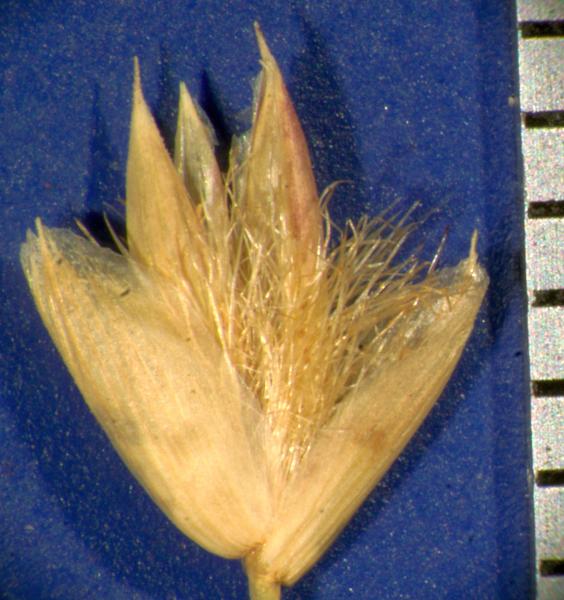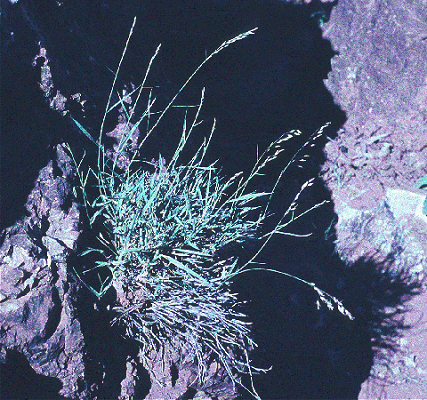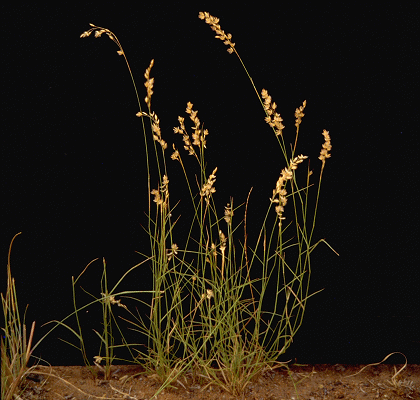Eriachne mucronata R. Br. Prodr. 184
(1810).
Classification. (GPWG 2001) : Subfamily
Micrairoideae. Eriachneae.
Type of Basionym or
Protologue Information: Australia, Broad Sound: Brown 6264 (BM holo,
CANB, E, K).
Key references
(books and floras): [1810]. R.Brown, Prodromus (184 & as Eriachne
brevifolia), [1878] G.Bentham, Flora Australiensis 7 (632), [1952]
C.A.Gardner, Flora of Western Australia 1 Gramineae (50), [1981]
M.Lazarides in J.Jessop (ed)., Flora of Central Australia (441), [2002]
D.Sharp & B.K.Simon, AusGrass, Grasses of Australia, [2006]
J.Jessop, G.R.M.Dashorst, F.M.James, Grasses of South Australia (421),
[2008] S.W.L.Jacobs, R.D.B.Walley & D.J.B.Wheeler, Grasses of New South
Wales (261).
Illustrations:
[2006] J.Jessop, G.R.M.Dashorst, F.M.James, Grasses of South Australia (422, fig. 352), [2008] S.W.L.Jacobs,
R.D.B.Whalley & D.J.B.Wheeler, Grasses of New South Wales, 4th edn
(261).
Habit.
Perennial. Culms geniculately ascending, 10–80 cm tall, wiry, 4–6 -noded.
Mid-culm nodes glabrous or bearded. Lateral branches sparsely branched or
branched. Ligule a fringe of hairs. Leaf-blades conduplicate, 2–5(–20) cm long,
1–2 mm wide. Leaf-blade surface smooth or scaberulous.
Inflorescence.
Inflorescence compound, a panicle. Panicle linear, 2–8 cm long, 0.5–1 cm wide.
Spikelets.
Spikelets pedicelled. Fertile spikelets 2-flowered, both fertile, comprising 2
fertile floret(s), without rachilla extension, ovate, laterally compressed, 5–6
mm long.
Glumes.
Glumes similar, thinner than fertile lemma. Lower glume ovate, membranous,
without keels, 9–13 -nerved. Lower glume surface glabrous or indumented. Lower
glume apex mucronate. Upper glume ovate, 4–7 mm long, membranous, without
keels, 9–13 -nerved. Upper glume surface smooth or scabrous, glabrous or
indumented. Upper glume apex mucronate.
Florets.
Fertile lemma 5–7 mm long, without keel, 5 -nerved. Lemma surface indumented.
Lemma apex mucronate. Palea apex entire or dentate. Grain 2 mm long.
Continental
Distribution: Australasia.
Australian
Distribution: Western Australia, Northern Territory, South Australia,
Queensland, New South Wales.
Western Australia:
Gardner, Hall. Mueller, Canning, Carnegie, Giles, Helms, Fortescue, Ashburton,
Carnarvon, Austin. Irwin. Northern Territory: Central Australia North,
Central Australia South. South Australia: North-western, Lake Eyre,
Gairdner-Torrens Basin, Flinders Ranges, Eastern. Queensland: Burke,
Burnett, Cook, Darling Downs, Gregory North, Leichhardt, Maranoa, Mitchell,
North Kennedy, South Kennedy, Warrego. New South Wales: North-Western
Plains, North Far Western Plains.
Notes.
This species is highly variable in habit, varying from elongated, loose largely
glabrous plants, with mostly simple culms, short leaf sheaths and
well-developed panicles (representing the mesophytic form) to xerophytic plants
which have a short compact habit, strongly branched culms, overlapping leaf
sheaths, and reduced often racemose inflorescences of usually few spikelets. The
blades are relatively long and herbaceous or short, tough pungent with a woolly
or hispid or tubercled indumentum. The morphology and indumentum of the
spikelet are generally uniform. The lemma is abruptly contracted at the apex
into a mucro, and its pubescence is confined to the lower part of its dorsal
surface. On comparison, the lemmas of the allied E. obtusa and E.
helmsii are evenly narrowed to the apex, usually muticous, and have ciliate
margins as well as surface pubescence.
Endemic.
All mainland States (excluding Victoria) between 2ºS and 32ºS. A common,
widespread and adaptable species. The xerophytic forms predominate in skeletal
and shallow soils on rocky or gibber slopes and crests of hills, ridges,
plateaux, mesas, rises and tablelands of sandstone, quartzite, laterite,
granite and calcareous rocks, often occupying sandy pockets, gullies, crevices
and beds of seasonal creeks and drainage lines. The mesophytic forms occur on
deeper, finer-textured sands, sandy and clayey loams, and red earth soils in
flat to gently undulating country and outwash plains. Flowers and fruits in all
seasons in Qld and N.T.; Feb.-Apr. (late-summer and autumn) in N.S.W.; chiefly
Aug.-Sept. (late-winter to early-spring) in S.A.; chiefly Apr.-Sept.
(mid-autumn to early-spring) in W.A.
